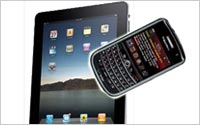Scaling Content: Marketers Must Adapt To Ecommerce, MCommerce Shifts
- by Laurie Sullivan @lauriesullivan, February 14, 2013
 Smartphones and tablets
now drive one out of every three minutes spent with digital media. As digital consumers become more reliant on mobile devices, the advertising and marketing industry can only expect content
consumption to rise.
Smartphones and tablets
now drive one out of every three minutes spent with digital media. As digital consumers become more reliant on mobile devices, the advertising and marketing industry can only expect content
consumption to rise.
Smartphones are surpassing 50% U.S. market penetration in 2012, reports comScore, which detailed digital media trends in its U.S. Digital Future In Focus 2013 report. It points to the shift in use and attribution patterns for mobile and desktop Web. Companies will need to become smarter about scaling their content to other platforms by developing integration strategies that deliver unique offerings to advertisers.
As the e-commerce and m-commerce channel shifts accelerate, companies that are unable to maintain market shares from one channel to the next will suffer. During a SEMPO L.A. roundtable on retargeting Wednesday night at Google in Venice, Calif., Magnetic CEO James Green said attribution across channels will become one of the most important strategies for 2013.
The industry continues to witness the decline of traditional media sources. Despite the 5% increase in the total U.S. Internet population, in the past two years, newspaper media consumption across the Web fell 5%; maps, 2%; weather, 12%; directories, 23%; comparison shopping, 4%; and instant messengers, 52%, according to comScore. The report explains reasons for the declines.
For example, softness in Web-based comparison shopping reflects the growing showrooming phenomenon, where consumers use their smartphones while in brick-and-mortar retail stores to obtain competitive pricing information.
comScore calls mobile commerce a threat on multiple fronts: to brick-and-mortar retailers competing with e-commerce retailers on mobile devices, and to less established e-commerce retailers that must compete for mobile transactions, despite being unlikely to own app real estate on smartphones.
Apps dominate smartphone media use, accounting for four in every five minutes spent on smartphones, with mobile Web use taking the rest. When it comes to apps, Facebook finished 2012 in the No. 1 position among use, reaching 76% of the smartphone market. The social site also garnered the heaviest engagement from smartphone users, accounting for 23% of all time spent on mobile apps.
Following Facebook’s lead in the app market, Google apps dominated the remainder of the list of top apps visited in the U.S., with Google Maps, Google Play, Google Search, Gmail and YouTube ranking as the most heavily visited apps, next to Facebook, according to comScore. The data company said Google apps also accounted for approximately 10% of all time spent on apps in December 2012.



Do you think that brick and mortar stores will need an eCommerce platform just to stay in business in the future?
My site provides social tools to help these eCommerce sites become more interactive with the social communities. We feel this is the best way for eCommerce to grow business; http://bit.ly/VccB1t.
Interesting that Facebook and Google together make up only 1/3 of phone app useage. Shows it's still an immature market where small players still have a chance.